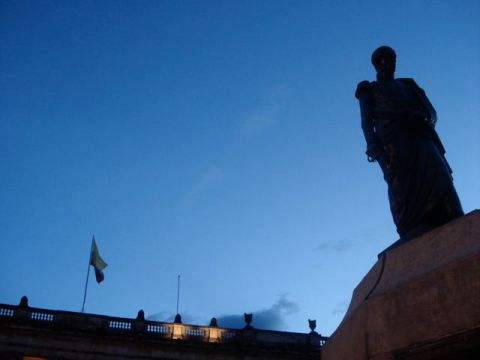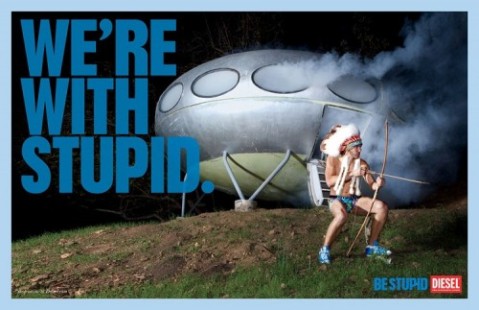“We Have Not Forgotten How To Laugh”
June 4, 2012
On Thursday I attended the opening evening of the Truth and Reconciliation Event in Toronto. Like many of these events, the evening included statements of support and challenge as well as musical and artistic performances. Lt. Governor David Onley pledged his ongoing support for the work of the commission while Chief William Montour of the Six Nations of Grand River called the TRC toothless, pushing for more recognition of ongoing issues facing First Nation communities such as land, health and housing.
As always, the evening focused on some difficult truths, about Canada’s colonial history and about a challenging road ahead. But the event was also a celebration of sorts, a celebration of resilience. The MC for the evening, Cynthia Wesley-Esquimaux, noted that even in the face of incredible obstacles and hardship, “we have not forgotten how to dance and we have not forgotten how to laugh.”

Two young Inuit throat singers were a great example of this laughter and resilience. The two young women stood on stage, holding each other by the arms, standing face to face. They began the rhythmic humming and deep gutteral sounds of throat singing. An exercise in both competition and collaboration, each song ended in laughter. I am by no means an expert in Inuit throat singing, and so all I will say about their performance is that it was beautiful, and that their laughter was inspiring.
CFP: Encuentro 2012
July 20, 2011
Every few years, the Hemispheric Institute of Performance and Politics holds an amazing conference. It’s called the “Encuentro,” meaning “meeting” or “encounter.” I had the pleasure of attending the Encuentro in 2009, held in Bogotá, Colombia. (See my posts on the event: Part I and Part II.) It was absolutely fantastic, an engaging 9 days spent with inspirational people. I highly recommend the conference, and it would be great to see a large Canadian contingent there! See the CFP below:
Cities | Bodies | Action
The Politics of Passion in the Americas
March 17-25, 2012
Universidad del Claustro de Sor Juana
Centro Histórico, Mexico City
The 8th Encuentro of the Hemispheric Institute seeks to examine the broad intersections between urban space, performance and political/artistic action in the Americas. From the critical poetics of body art to the occupation of public space by social movements, the event invites participants to explore the borders, identities and practices through which subjectivities, hegemonies and counter-hegemonies are constructed in the spaces of the city and beyond. We are particularly interested in the ways in which bodies both interpellate and are interpellated, mobilize and are mobilized, by and around the diverse and complex passions that define our globalized and mediatized present—fear, hatred, disenchantment, hope and faith, among others. We seek to investigate, collectively, the strategies through which bodies (individual, social and political) make themselves present, and intervene aesthetic conventions, social formations and political structures in their search to create new meanings and new modes of sociality. This theme will be the point of departure for a vast array of performances, exhibits, roundtables, workshops, lectures and work groups.
Since 2000, our Encuentros have been a point of contact for artists, scholars, students and activists interested in the relationship between performance and politics in the Americas. Each Encuentro brings together 400-600 participants, and is part academic conference, part performance festival, and always interdisciplinary. The Encuentro is a space focused on experimentation, dialogue and collaboration.
The application deadline for the Encuentro is September 26, 2011. To apply, see the instructions on our website (Propose a Project or Apply to a Work Group) and then fill out the Online Application in English.
Images from the IRS TRC’s first national gathering
June 17, 2010
The first day of the IRS TRC’s first national gathering was long. It started at sunrise for the lighting of the sacred fire ceremony and ended just before midnight with amazing musical performances from Buffy St. Marie and Blue Rodeo, among others.
The first day’s events were a reminder of how much there is to work through, about the challenges facing the process of reconciliation, as well as the hope that comes with embarking on this path. I am continually humbled by the strength of the survivors and others who have told their stories (and by those who have not), and their families. I hope to write more about the event, but for now, here are a few of images from the first day of the national gathering in Winnipeg.
“I believe that in the indeterminacy of drawing – the contingent way that images arrive in the work – lies some kind of model of how we live out lives. The activity of drawing is a way of trying to understand who we are and how we operate in the world.”
– William Kentridge
An exhibit of William Kentridge’s work is currently on display at MOMA in New York until May 17, 2010. I went to see it the other day with my friend Lauren and am now completely enamored with his work. Before visiting the exhibit, I knew a bit about the artist, mostly through his work on an amazing play called Ubu and the Truth Commission, but didn’t have a sense of his range and diversity. For the most part, Kentridge, a South African artist, deals with the realities of living in an apartheid and post-apartheid state. He engages issues of oppression, resistance, hatred, love and desire through several mediums including drawing, film, printmaking, collage, and theatrical performance. Go see it!
The image above: William Kentridge. Drawing from Stereoscope 1998-99. Charcoal, pastel, and colored pencil on paper. For more on Kentridge at MOMA click here or for a review, click here.
Things that Confuse Me
February 24, 2010
1. Diesel’s latest campaign:
2. Russian figure-skaters Oksana Domnina and Maxim Shabalin at the Olympics:
Confusing, right?
Check out Sociological Images for more on the Diesel Campaign, and Native American Legal Update for more on representations of indigenous peoples during the Olympics.
How Can We Remember – Lecture
February 1, 2010
Beautiful Bogotá: Part I
September 15, 2009

Plaza de Bolívar, Bogotá
This August I had the pleasure of attending the Encuentro, a conference organized by the Hemispheric Institute at NYU, in Bogotá, Colombia. It was an amazing ten days filled with performances, roundtables and work shops. I participated in a work group led by Peter Kulchyski and Edwin E. Corbin Gutiérrez where I presented my research on the Truth and Reconciliation Commission in Canada. The other presenters were artists, activists and academics who are working in communities around the world on issues ranging from the right to education, social justice, the re-appropriation of public spaces, and art as activism. It was amazing and inspiring.
Some of the highlights from the conference include Andreas Huyssen’s keynote address on “Natural Rights, Civil Rights and the Politics of Memory,” Mary Louise Pratt’s keynote entitled “Language Ecology, Language Politics: Towards a Geolinguistic Imagination,” and the Roundtable addressing “The Struggles Over Citizenship.”
There was also plenty of controversy. Performer Tania Bruguera, for example, incorporated cocaine into her performance, inviting audience members to partake in the drug. In a roundtable discussion a few days later she tried to explain her motivation behind the performance, linking this performance to a series she was doing in Cuba and a planned performance in Palestine. For the most part, the audience seemed offended by her work, charging her with being irresponsible and self-indulgent.











